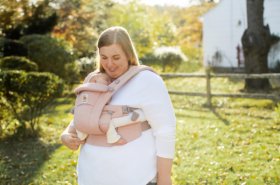Different Types of Baby Carriers
The best baby carrier is one that safely and ergonomically holds your baby, is comfortable for you and your baby, is simple to use and offers the functionality your lifestyle requires. But after years of caregivers trying different babywearing methods, coupled with today’s technology, you’re presented with more carrier choices than ever. How do you choose which infant carrier to get?
The four most popular types of baby carriers include:
- Wraps / Mei Tais
- Ring Slings
- Soft-structured Carriers
- Woven Wraps
| Carrier Type | Sizes | Pros | Cons |
| Stretchy Wraps | Newborn to 4-6 months | – Can use one wrap for one or two babies
– Can be left on so you don’t have to retie it multiple times throughout the day – Front carry positions – Affordable – Compact, fits nicely in a diaper bag |
– Learning curve if you’ve never used a wrap |
| Hybrid Wraps | Newborn to 1 year | – Front carry positions
-Compact and cozy -Soft like a wrap with less of a learning curve |
– Only useable up to about 1 year of age
– Front carry positions only |
| Woven Wraps | Newborn to toddler | – Designed not to stretch, so it’ll hold your babies even as they grow
– Front, hip, and back carry positions – Compact, fits nicely in a diaper bag |
– Can be hard to learn and get the right fit
– Not the most comfortable or supportive option if long-term wearing |
| Ring Slings | Newborn to toddler | – Lightweight, breathable material
– Compact, great for traveling – Front, hip, and back carry options – Easy to get on and off once you get the hang of it |
– Can be restricting around the neck and bulky at the shoulders
– Not much back support for the wearer |
| Soft Structured Carriers | Newborn to toddler (dependent on the type of SSC) | – Versatile and adjustable
– Front, hip, and back carry positions – Can work in combination with other types of baby carriers – Quick to learn, fast to put on |
– Can be difficult to put on and adjust with multiple buckles and straps |
Stretchy Wraps

Stretchy wraps, like our Aura Wrap, are popular because they are incredible soft and incredibly easy to pack in a diaper bag for any adventure the day might bring. Once you get used to tying the baby carrier wrap, it becomes like second nature and some people choose to leave it on for the day instead of retying multiple times. Stretchy wraps only offer the front inward carry position and you’ll typically need to graduate to a more supportive carrier once your little one hits about 1 year old.
Hybrid Wraps
Our hybrid wrap, Embrace, gives you the coziness of a stretchy wrap with the ease and support of a soft structured carrier. We might be partial, but it’s one of our favorites. With this hybrid wrap you can use front inward carry and front outward carry (when developmentally appropriate) and it’s just as compact as a wrap so you can take it with you everywhere! Easy to take on an off, even easier to make newborn snuggles a breeze, Embrace Newborn baby carrier comes in two different fabrics, a variety of colors, and supports you and your newborn through their first year.
Ring Slings
Ring slings are a really fun fashion statement and another type of carrier that, although the learning curve is initially tricky, once you get the hang of it, it’s very easy to use. Baby sling carriers are lightweight and breathable, and another compact option for traveling. You can wear babies with a front inward carry, hip carry, and even a back carry! Many of the common complaints are regarding the bulkiness around the shoulders and the lack of back support, which is why we recommend using ring slings for short amounts of time to protect you and your little one.
Soft Structured Carriers
Soft structured carriers (SSCs) are probably the most widely known baby carrier in the western world and our SSCs are what has made Ergobaby one of the most highly recommended carriers on the market! These types of carriers are the most versatile with front, hip, and back carry positions. These carriers give support in all the right places for both parent and baby, protecting developing hips and parents’ packs. These carriers are the easiest to learn and quick to put on.
We offer a variety of soft structured carriers because your carrier should be as unique as you are! Whether you love to adventure and need something more breathable, or you’re concerned about using sustainable goods, there is something for everyone.
Looking for carriers that will support bigger kids? We got you! Alta Hip Seat baby carrier is great for quick ups and downs for growing little ones that want to be a part of all the action.
Our sister brand, Baby Tula, makes Toddler and Preschool Carriers so the snuggles and adventures don’t have to stop as your little ones grow.
The Great Debate: Facing In vs. Facing Out
When it comes to facing in or facing out, it’s important to first consider your baby’s mental and physical developmental milestones before anything! Using a carrier that supports your little one’s body as it’s growing is crucial to their development.
| Carry Position | Age and Developmental Milestones | Best Ways to Use |
| Front Inward Carry | Newborn-+ | Front inward carry is the most common carry and is best all day, every day. Consider it for bonding, resting, or calming a fussy baby. |
| Front Outward Carry | 6 months+
Must have good head and neck control |
This carry is best used for short amounts of time to protect the caregivers back. It’s convenient for around the house, quick errands, or adventures where your little one wants to engage with their surroundings. |
| Back Carry | 6 months +
Must have good head and neck control |
Back carry is great for walks, hikes, running errands, and other adventures. |
| Hip Carry | 6 months +
Must have good head and neck control |
Hip carry is a convenient option for when your little one wants to see your face, but you need more flexibility. Like doing household chores, grocery shopping etc… |
Front Inward Facing Position
For the first several months, the baby is more than content with being carried in the front position, facing inward towards the caregiver. From a developmental point of view, the baby’s primary tasks are related initially to adaptation to life outside the womb. Their main interest will be the human face, and the front inward facing position will continue to be ideal for most babies as they will have a clear view of the caregiver’s face and eventually the surrounding environment.
Front Outward Facing Position
Your little one is ready for outward facing carry if:
- They’re fussing while facing inward when they normally love it
- They are 6 months old and have solid head and neck control
Signs your little one might be overstimulated in the outward facing carry:
- Gets fussy or agitated
- Gets sucked into surroundings and can’t disengage (a sign of feeling insecure)
Front outward facing position is great for little ones that are getting more interested in their surroundings and want to engage more. Always listen to your baby’s cues and switch positions if they are unhappy!
Front outward facing for long periods of time is not recommended as it can interfere with the parents’ ability to respond to and communicate with their babies and places strain on the caregivers back as it’s more difficult to carry a load that’s facing away from you.
When your baby is in the front outward facing position, they are cut off from having a clear view of the caregiver’s face, which is vital for the optimum neurological development of the baby’s brain, which is why we don’t recommend outward facing until at least 6 months of age.
Honoring the Heritage of Babywearing
Babywearing is not a new concept even though it’s relatively new to the Western world. Learn more about the history of babywearing and honor its heritage!



